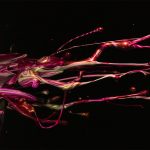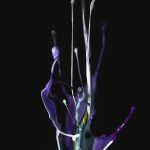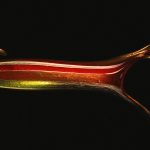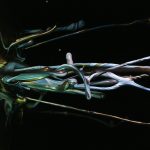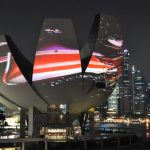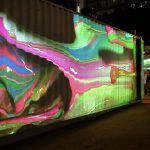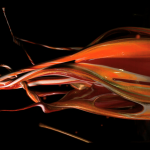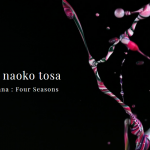Description of the Work:
Title: “Sound of Ikebana: Spring (New Edition),” Date: 2019,
Media: Video (Color, Sound), Time length: 6 min., Size: 3840 x 2160 pixels.(Note: Sound of Ikebana Four seasons, HD.
Sound of Ikebana (Spring) is a video artwork created through the search of finding hidden beauty in nature using technologies. Propelled by sound and shot by a high speed camera, elegant splashes of color fly in slow motion across a dark screen. Sound of Ikebana (Spring) is a part of a four-channel video art series designed to express Japan’s four seasons. It uses the unpredictable natural phenomena of sound vibrations and colorful paint of different consistencies to create intriguing and mesmeric shapes that evoke the art of ikebana, Japanese flower arrangements based around asymmetrical triangular forms. The colors Naoko Tosa uses are inspired both by spring images such as apricot flowers and cherry blossoms, as well as the white and gold of the Japanese New Year. Her slow-motion liquid, filmed at 2000 frames per second, blends artistic traditions with cutting-edge technology and organic designs, inviting audiences to a contemplative visual connection with traditional Japanese culture and its history.
Other than Sound of Ikebana: Spring, there are below works in the series.
Title: “Sound of Ikebana: Summer (New Edition),” Date: 2019, Media: Video (Color, Sound), Time length: 6 min., Size: 3840 x 2160 pixels.
Title: “Sound of Ikebana: Autumn (New Edition),” Date: 2019, Media: Video (Color, Sound), Time length: 6 min., Size: 3840 x 2160 pixels.
Title: “Sound of Ikebana: Winter (New Edition),” Date: 2019, Media: Video (Color, Sound), Time length: 6 min., Size: 3840 x 2160 pixels.
Below are several other video arts by Naoko Tosa.
Title: “Space Flower,” (Set of 4 videos) Date: 2014, Media: Video (Color, Sound), Time length: 5.5 min., Size: 1920 x 1080 pixels.
It is said that RIMPA, one of the well-known art schools, originated Japanese design. The RIMPA school has the elegance of Yamato-e, as well as the innovative sense and technology. As 400 years have passed since the beginning of the school, I tried to express the present RIMPA world by my video art. Thus I have created video artworks that visualize flowers living in the weightless space of the universe, flowers living and falling in the tropical rain forest of the universe, images of moon flowers, and images of cosmic Geisha-Girl.
“Space Flower” consists of four video arts. Each work can be watched at the below URL.
Space Flower Movie: https://youtu.be/AGVPTdKZhJ4
Space Jungle Movie: https://youtu.be/cKktfhh8hm0
Moon Flower Movie: https://youtu.be/yHNHLCSyPeI
Oiran(花魁)Movie: https://youtu.be/YOCHFBE-AGw
Title: “Wind God and Thunder God,” (Set of 2 videos) Date: 2014, Media: Video (Color, Sound), Time length: 6.45 min., Size: 1080 x 1920 pixels.
A tribute to “Wind God and Thunder God,” one of the representative artworks of RIMPA, which is said to be the beginning of Japanese design. Naoko Tosa expressed the power of life by the story of coming and leaving of the invisible Wind God in a calm and dynamic manner.
Thunder God Movie: https://youtu.be/aO02l5BbkVw
Wind God Movie: https://youtu.be/KMe104bceBk
Title: “TOSA RIMPA,” Date: 2015, Media: Video (Color, Sound) Time length: 6.34 min., Size: 3840 x 2160 pixels.
Naoko Tosa expressed a beauty form that has integrated the symmetrical Western beauty and the organic Eastern beauty using Ikebana generated by sound vibration. She calls the form as “TOSA RIMPA.”
Sample Movie: https://youtu.be/kWHQXTf1KLM
Title: “Organic Geometry,” Date: 2015, Media: Video (Color, Sound), Time length: 6 min., Size: 3840 x 2160 pixels.
Naoko Tosa expressed beauty form that have integrated the symmetrical Western beauty and the organic Eastern beauty.
Movie: https://youtu.be/XzYmUvXB_ho
Title: “Organic Geometry2 (Reflection)” Date: 2015, Media: Video (Color, Sound) Time length: 6.43 min., Size: 3840 x 2160 pixels.
Naoko Tosa expressed beauty form that have integrated the symmetrical Western beauty and the organic Eastern beauty using reflection effect.
Sample Movie: https://youtu.be/1nzE1tZXAsA
Title: “Utsuroi,” Date: 2015, Media: Video (Color, Sound), Time length: 5.36 min., Size: 3840 x 2160 pixels.
Based on the concept of creative destruction, Naoko Tosa destroys traditional Japanese flower arrangement and expresses the traditional Japanese aesthetic sense called “Utsuroi”.
Sample Movie: https://youtu.be/aaQNSNmR7Bw
Sample Movie: https://youtu.be/fP8lcGA-ZMw
Title: “The Place You Will Never Visit,” Date: 2015, Media: 4K Video (Color, Sound), Time length: 7 min, Size: 3840 x 2160 pixels.
Naoko Tosa guides customers to the small micro-world we found using Japanese sweets in Kyoto. It expresses Japanese traditional aesthetic sense that values small cute things.
Sample Movie: https://youtu.be/yM4ehpWtTDs
Title: “Volcano,” Date: 2015, Media: Video (Color, Sound) Time length: 6 min., Size: 3840 x 2160 pixels.
Naoko Tosa expressed vitality of volcanic eruption using the Japanese aesthetic sense.
Sample Movie: https://youtu.be/S4b5rZJ39P4
“Genesis” series description
We recognize that our own existence as a solid individual isolated from the outside world, but in fact it is nothing more than a liquid in constant inflow and outflow. Furthermore, it can be said that it is like a gas with no fixed form in which molecules and atoms slowly move around and there is no constant border or interface between itself and outside atmosphere.
Title: “Genesis – Red,” Date: 2017, Media: Video (Color, Sound), Time length: 5 min., Size: 3840 x 2160 pixels.
Movie: https://youtu.be/7MmZsMgnuKE
Title: “Genesis – Yellow” Date: 2017, Media: Video (Color, Sound), Time length: 5 min., Size: 3840 x 2160 pixels.
Movie: https://youtu.be/-kmjhAeGK1s
Title: “Genesis – Green” Date: 2017, Media: Video (Color, Sound), Time length: 5 min., Size: 3840 x 2160 pixels.
Movie: https://youtu.be/WpXR_U2euYQ
Title: “Genesis – Blue” Date: 2017, Media: Video (Color, Sound), Time length: 5 min., Size: 3840 x 2160 pixels.
Movie: https://youtu.be/aF0dhqix5YA
Title: “Genesis – Purple” Date: 2017, Media: Video (Color, Sound), Time length: 5 min., Size: 3840 x 2160 pixels.
Movie: https://youtu.be/wYzlx2FMjcc
Title: “Genesis – Pink” Date: 2017, Media: Video (Color, Sound), Time length: 5 min., Size: 3840 x 2160 pixels.
Movie: https://youtu.be/Wse04F4EqXA
Title: “Genesis – Gold Waterfall” Date: 2017, Media: Video (Color, Sound), Time length: 5 min., Size: 3840 x 2160 pixels.
Movie: https://youtu.be/jSjRxI25B_I
Title: “Chinese Four Gods White Tiger,” Date: 2018, Media: Video (Color, Sound), Time length: 5 min., Size: 2160 x 3840 pixels.
This is a video artwork shot by a high-speed camera, with raw Japanese lacquer placed on a speaker and flown up according to the vibration of sound. The created form looks like White Tiger.
The White Tiger is one of the Four Symbols of the Chinese constellations. It is sometimes called the White Tiger of the West (西方白虎, Xī Fāng Bái Hǔ), and is known as Bái Hǔ in Chinese, Byakko in Japanese, Baekho in Korean and Bạch Hổ in Vietnamese. It represents the west and the autumn season.
Movie: https://youtu.be/tRceGncpObk
Title: “Chinese Four Gods Black Turtle,” Date: 2018, Media: Video (Color, Sound), Time length: 5 min., Size: 2160 x 3840 pixels.
The Black Tortoise or Black Turtle is one of the Four Symbols of the Chinese constellations. Despite its English name, it is usually depicted as a turtle entwined together with a snake. Further, in East Asia, it is not called after either animal but is instead known as the “Black Warrior” under various local pronunciations. It is known as Xuánwǔ in Chinese, Hyeonmu in Korean, Genbu in Japanese and Huyền Vũ in Vietnamese. It represents the north and the winter season.
This is a video artwork shot by a high-speed camera, with raw Japanese lacquer placed on a speaker and flown up according to the vibration of sound. The created form looks like Black Turtle.
Movie: https://youtu.be/0obS8Zx3h6U
Title: “Chinese Four Gods Vermilion bird,” Date: 2018, Media: Video (Color, Sound): Time length: 5 min., Size: 2160 x 3840 pixels.
The Vermilion bird is one of the Four Symbols of the Chinese constellations. According to Wu Xing, the Taoist five-elemental system, it represents the fire-element, the south direction, and the summer season correspondingly. Thus it is sometimes called the Vermilion bird of the South (南方朱雀, Nán Fāng Zhū Què). It is known as Zhū Què in Chinese, Suzaku in Japanese, Jujak in Korean and Chu Tước in Vietnamese. It is described as a red bird that resembles a pheasant with a five-colored plumage and is perpetually covered in flames. Represented by Jonangu Shrine in the southern part of Kyoto.
This is a video artwork shot by a high-speed camera, with raw Japanese lacquer placed on a speaker and flown up according to the vibration of sound. The created form looks like Vermilion bird.
Movie: https://youtu.be/wxbsGSPp-eM
Title: “Chinese Four Gods Azure Dragon,” Date: 2018, Media: Video (Color, Sound), Time length: 5 min., Size: 2160 x 3840 pixels.
The Azure Dragon (青龍 Qīnglóng), also known as Bluegreen Dragon or Green Dragon, also called the Blue Dragon (蒼龍 Cānglóng), is one of the Dragon Gods who represent the mount or chthonic forces of the Five Forms of the Highest Deity (五方上帝 Wǔfāng Shàngdì). He is also one of the Four Symbols of the Chinese constellations, which are the astral representations of the Wufang Shangdi. The Bluegreen Dragon represents the east and the spring season.[1] It is also known as Seiryu in Japanese, Cheong-ryong in Korean, and Thanh Long in Vietnamese.
This is a video artwork shot by a high-speed camera, with raw Japanese lacquer placed on a speaker and flown up according to the vibration of sound. The created form looks like Azure Dragon.
Sample Movie: https://youtu.be/B5Ytkrr034U
BIO
NAOKO TOSA, Born in 1961 at Fukuoka/Japan, is an internationally renowned Japanese media artist. She received PhD degree on Art and Technology from the University of Tokyo in 1999. She was Fellow Artist at CAVS (Center for Advanced Visual Studies) of Massachusetts Institute of Technology (MIT) in 2002-2004. In 2005 she joined Kyoto University, and is now Professor at Graduate School of Advanced Integrated Studies in Human Survivability (GSAIS). She received many international and domestic awards. Her collaborations with experts in different genres, such as with Ippei Shigeyama (Noh performer), Ryuho Sasaoka (school master of Mishoryu Sasaoka Ikebana School), Toshinori Kondoh (trumpeter), have been highly evaluated.
In 2016 she was appointed by the Agency for Cultural Affairs, Government of Japan as a Japan Cultural Envoy 2016 and carried out world tour exhibition her artworks. The highlight of the tour was the exhibit of Sound of Ikebana (Spring) at Times Square, New York. As a part of Midnight Moment, a monthly presentation by the Times Square Advertising Coalition (TSAC) and Times Square Arts, in partnership with the Japan Society Gallery, Naoko Tosa’s Sound of Ikebana was exhibited using more than 60 Times Square’s electronic billboards from 11:57 pm to midnight every night in April 2016.
Museum collection
The Museum of Modern Art in New York, The National Museum of Art, Osaka/Japan, The Museum of Modern Art, Toyama/Japan, Nagoya City Art Museum, Nagoya/Japan, and Takamatsu City Museum of Art, Takamatsu/Japan.
Public installation
Public installation include two exhibits at Keninin-ji Temple, one of the top class Zen temples in Kyoto. One is “Sansui on the Cloud” as twelve hanging scrolls made from around 1000 cloud photos. Another is “Silence,” which is a photo art featuring an old tree with more than 200 years history at the temple. Both are now permanent collection at Kennin-ji Temple.
Awards
First prize of L’Oreal Grand Prix(1997); Accepted for Interactive Art section Award in ARS Electronica(2000); Second prize for Nabi Digital Storytelling Competition of Intangible Heritage by Art Center Nabi under the official endorsement of UNESCO(2004); Honored EXPO 2012 Committee by the display of her digital art work on a huge LED screen for Yeosu EXPO in Korea (2012); Good Design Award Japan by the projection mapping of “Sound of Ikebana”(2014), etc.
Exhibitions
Invited to participate “New Video Japan” (MoMA, 1986); Video art “An Expression” was entered in permanent collection of MoMA(2011); Exhibit of “An Expression” at MoMA Media Lounge(2012-13); Exhibit of her artwork on LED screen of 250m x 30m at Yeosu Expo in Korea, 2012; Solo exhibition of “Sound of Ikebana” at Art Science Museum in Singapore, 2013; Projection Mapping of “Tosa Rimpa: 21st Century Legend of Wind God & Thunder God” at Kyoto National Museum, 2015 celebrating Rimpa School 400th anniversary in collaboration with Ippei Shigeyama, Kyogen performer, and Ryuho Sasaoka, school master of Mishoryu Sasaoka Ikebana School; Selected for “Artist of April” of Times Square Midnight Project (New York, 2017), etc.
Books
She has published many books such as “Cultural Computing” (2009 NTT Publishing), “TOSA RIMPA” (2015, Tankohsha Publishing), “Cross Cultural Computing: An Artist Journey” (2016 Springer).
https://www.springer.com/jp/book/9781447165118
